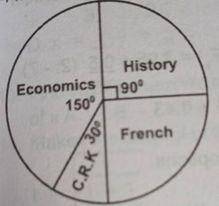
25
15
10
8
Correct answer is C
Total number of students (y) using the subject French
( 90 / 360 )º x Y = 30
Y = 30 x 4
Y = 120
History- 90º + French- 90º + Economics- 150º + CRK = 360º
CRK = 360º - 330º = 30º
Number that offered CRK:
( 30 / 360 )º x 120 = 10
27o
30o
54o
108o
Correct answer is D
Number of 15- year old pupils = 30.
Total number of students: 3 + 10 + 30 + 42 + 15 = 100.
Angle = \(\frac{30}{100} \times 360°\)
= \(108°\)
24
22
21
20
Correct answer is D
\(\frac{\mathrm d y}{\mathrm d x} = 3x^{2} - 2x + 1\)
\(y = \int_{1} ^{3} (3x^{2} - 2x + 1) \mathrm d x\)
\(y = [x^{3} - x^{2} + x]_{1} ^{3}\)
= \([3^{3} - 3^{2} + 3] - [1^{3} - 1^{2} + 1]\)
= \(21 - 1 = 20\)
2x2 - 3x + 5
2x2 - 3x + 3
2x2 - 3x
4
Correct answer is B
∫dy = ∫(4x - 3)dx, y = 2x2 - 3x + C
when y = 5, x = 2, C = 3
y = 2x2 - 3x + 3
For what value of x is the tangent to the curve y = x\(^2\) - 4x + 3 parallel to the x-axis?
3
2
1
6
Correct answer is B
At the point where the tangent is parallel to the x- axis, the slope of the curve = 0.
Given: \(y = x^{2} - 4x + 3\)
\(\frac{\mathrm d y}{\mathrm d x} = 2x - 4\)
\(2x - 4 = 0 \implies 2x = 4 \)
\(x = 2\)
When x = 2, the tangent of the curve is parallel to the x- axis.
JAMB Subjects
Aptitude Tests